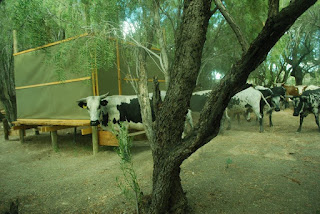For biology degrees we are required to take a few classes like the ones we took as an undergraduate, and take on a research project that we write about in a long document called a thesis or dissertation.
During the first couple of semesters we are taking 1 formal class (with tests and homework), a couple seminars (where we have work to do on a very specific subject, or we have to listen to science presentations), a lab to be a teach assistant of, and organizing the various stages of our research project. Towards the end of our time at school we are signed up for maybe 1 seminar and still have our lab to teach while working on our project.
Project process: The scientific method is followed for this.
1. Have a biology question to ask. This question is something you will have time to answer and is related to what your adviser (a professor) is working on.
2. Form an expectation of what you think the answer is to your question, commonly called a hypothesis, and make it based on previous research findings.
1&2 should be done in your first semester.
3. A methodical way to test your hypothesis is needed, so you design an experiment or observational study that will allow you to do some math to prove your expectations right or wrong.
4. Carry out the experiment or study and write down everything that you do and every piece of data that you can.
5. Copy your data from paper to computer format, unfortunately sometimes this can take a long time. 6. Figure out what math (statistics) you will use to show that your hypothesis is proven or not.
7. Write up a very long document covering all of these steps. With two long sections where you should be discussing what other people have discovered before you and how it relates to your work. In some cases students are answering more than one question about the same topic.
Usually if you bog down your family with details about your hypothesis, experiment, or results they tend to get a glazed over look on their face. It is best to keep it as simple as possible.
For example, here are two ways of explaining what I do for my project:
I'm trying to find out how long ash trees will live in the local park after a new insect that kills them has started living in the same area.
I'm creating a localized population viability model of green ash trees which have survived the initial mortality wave of the invasive emerald ash borer beetle.
Hope this helps, have a Happy Thanksgiving!
During the first couple of semesters we are taking 1 formal class (with tests and homework), a couple seminars (where we have work to do on a very specific subject, or we have to listen to science presentations), a lab to be a teach assistant of, and organizing the various stages of our research project. Towards the end of our time at school we are signed up for maybe 1 seminar and still have our lab to teach while working on our project.
Project process: The scientific method is followed for this.
1. Have a biology question to ask. This question is something you will have time to answer and is related to what your adviser (a professor) is working on.
2. Form an expectation of what you think the answer is to your question, commonly called a hypothesis, and make it based on previous research findings.
1&2 should be done in your first semester.
3. A methodical way to test your hypothesis is needed, so you design an experiment or observational study that will allow you to do some math to prove your expectations right or wrong.
4. Carry out the experiment or study and write down everything that you do and every piece of data that you can.
5. Copy your data from paper to computer format, unfortunately sometimes this can take a long time. 6. Figure out what math (statistics) you will use to show that your hypothesis is proven or not.
7. Write up a very long document covering all of these steps. With two long sections where you should be discussing what other people have discovered before you and how it relates to your work. In some cases students are answering more than one question about the same topic.
Usually if you bog down your family with details about your hypothesis, experiment, or results they tend to get a glazed over look on their face. It is best to keep it as simple as possible.
For example, here are two ways of explaining what I do for my project:
I'm trying to find out how long ash trees will live in the local park after a new insect that kills them has started living in the same area.
I'm creating a localized population viability model of green ash trees which have survived the initial mortality wave of the invasive emerald ash borer beetle.
Hope this helps, have a Happy Thanksgiving!


















